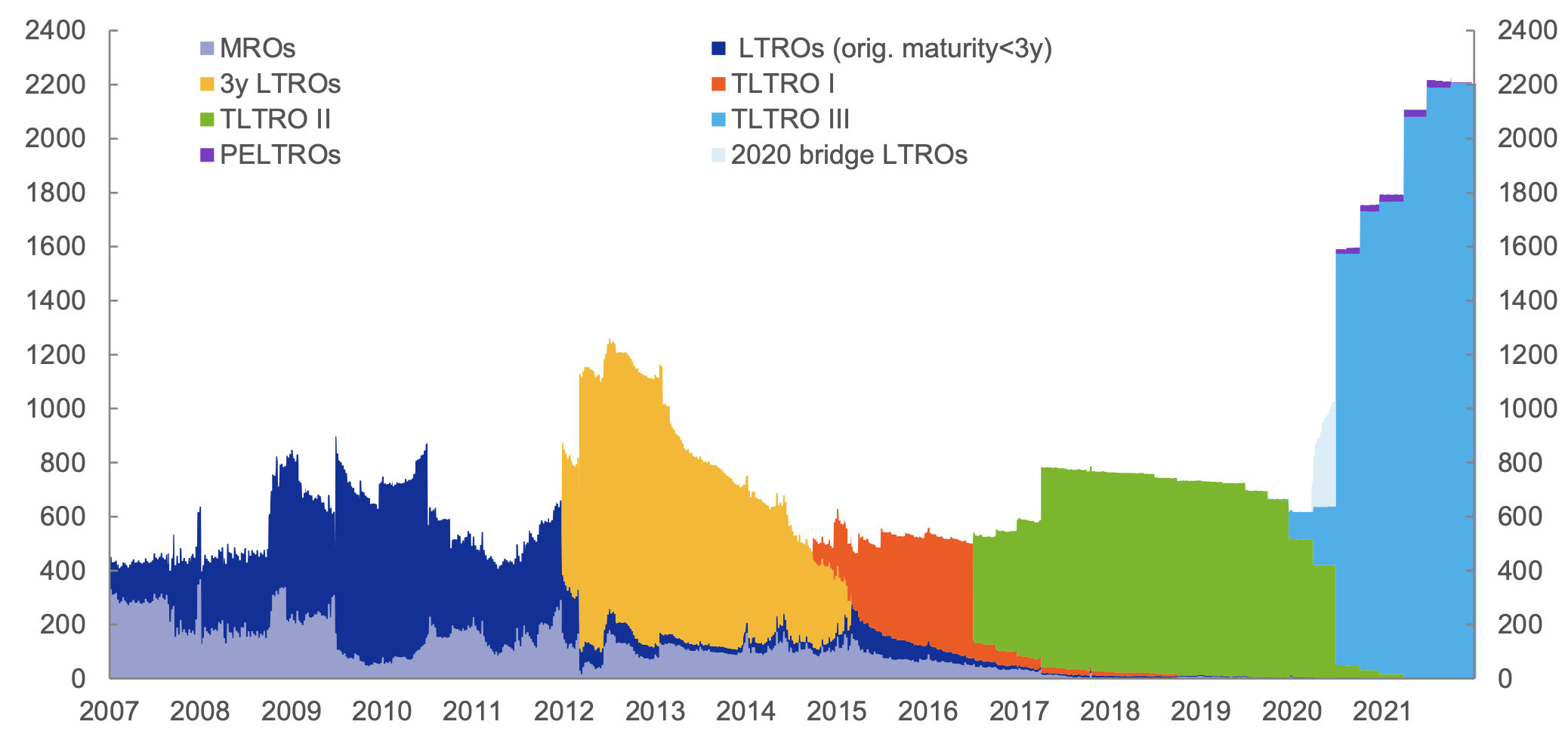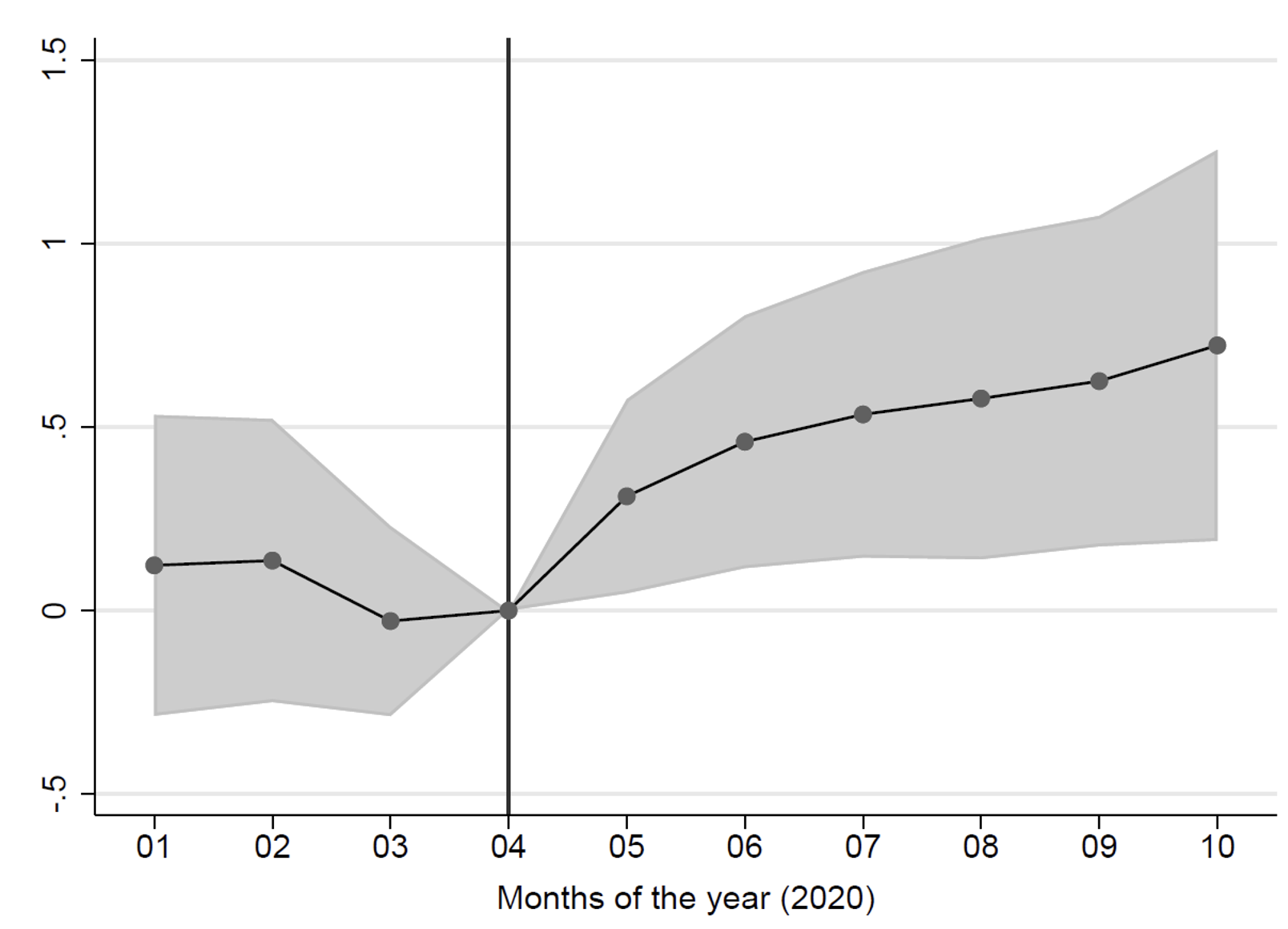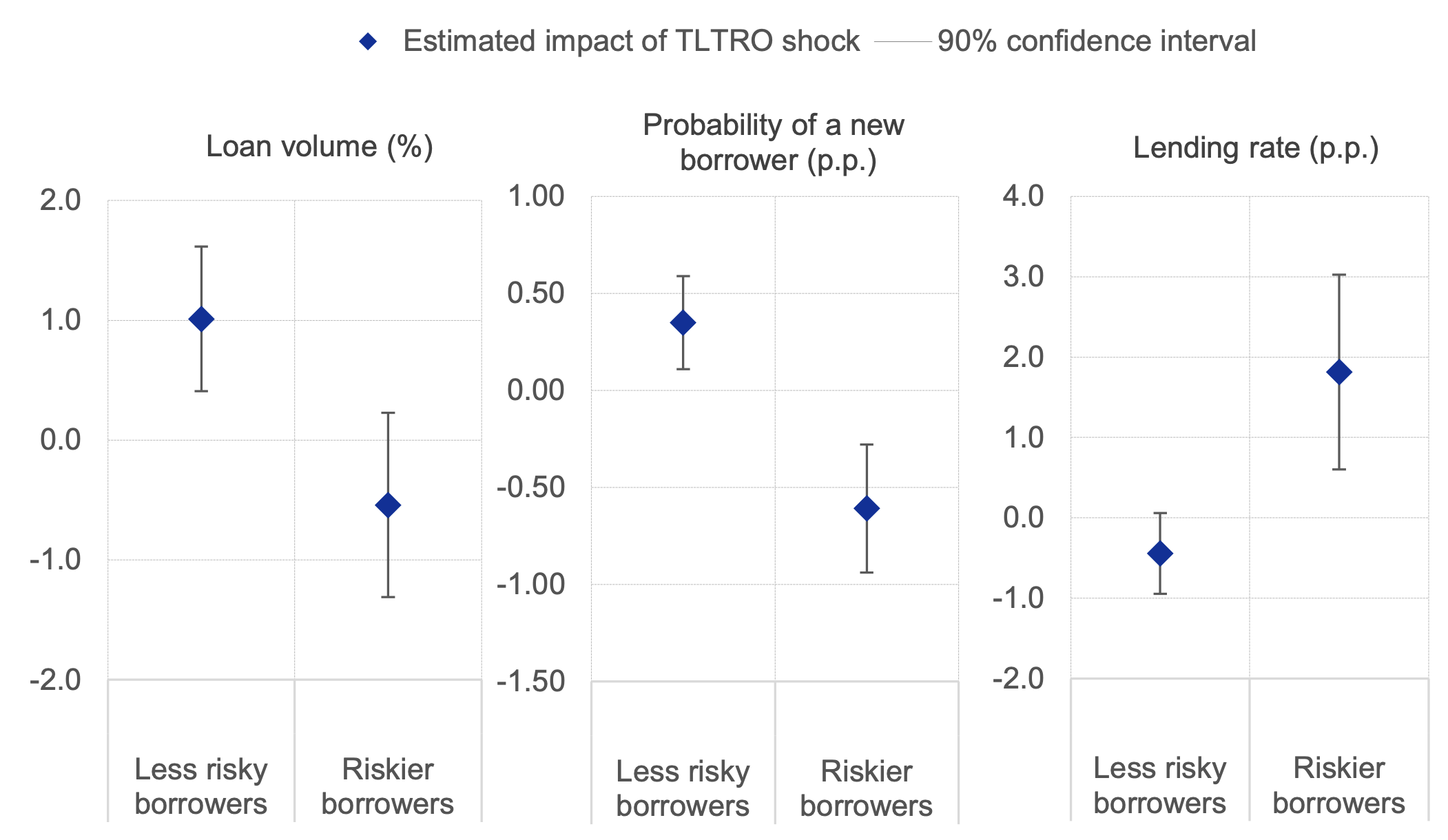Whether a low monetary policy rate spurs excessive risk-taking by banks has been a much-debated question in academic and policy circles since the start of the Global Financial Crisis (Dell'Ariccia et al. 2011, Ongena and Peydró 2011, Adrian and Shin 2018). While the impact of a monetary policy easing sustains bank profits even in a low-interest-rate environment via larger intermediation volumes and lower provisioning costs (Altavilla et al. 2018), a prolonged period of low or even negative policy rates may compress banks' profit margins if banks were not able to lower deposit rates below their effective lower bound (Lopez et al. 2018). This could, in turn, either reduce the room for manoeuvre for further monetary policy accommodation (Brunnermeier and Koby 2019, Heider et al. 2019) or raise financial stability concerns as banks try to recoup intermediation margins by lending to increasingly riskier borrowers (Bubeck et al. 2020).
Funding for lending schemes by central banks may partially compensate for the challenges brought forth by a prolonged low-interest-rate environment (Goodhart et al. 2020). The euro area version of such schemes, the so-called targeted longer-term refinancing operations (TLTROs), are an example of this design in action. The second series of TLTROs (TLTRO II) launched in 2016 leveraged on the negative interest rate policy (NIRP) by setting the lowest rate at which banks could obtain the funds, subject to conditions related to their lending performance, equal to the rate at which excess reserves are remunerated (the deposit facility rate, or DFR, at that time -0.4%), thus shielding banks from excessive pressure on their margins (Rostagno et al. 2021). Similarly, the lowest borrowing rate under the third series of operations (TLTRO III) launched in 2019 was indexed to the DFR, which was lowered again to -0.5% at the inception of the programme. Yet, the firepower of the scheme was greatly increased with the adoption of so-called 'dual interest rates', that is, central bank funding with an interest rate below the interest rate on reserves (Greene and Lonergan 2020).
In a new paper (Barbiero et al. 2022), we look at the experience of TLTRO III during the pandemic, which offers an unprecedented example of dual interest rates on a large scale. We find that central bank funding with dual interest rates enables an easing of bank lending conditions without the increased risk appetite that a standard rate cut might bring about, especially if considered after a prolonged period of low or negative interest rates.
At the height of the COVID-19 pandemic, the TLTRO tool was recalibrated to further support the continued access of firms and households to bank credit (Altavilla et al. 2020a). Crucially, the interest rate charged on borrowed funds could reach a minimum of 50 basis points below the DFR, which was well below the cost of any alternative funding source at the inception of the pandemic. The new design led to the largest liquidity injection in the history of the ECB and provided a large reduction in funding costs for euro-area banks (see Figure 1).
In the paper, we address two questions. First, we ask whether the recalibrations of the TLTRO interest rate to levels potentially below the remuneration of central bank reserves generated an increase in the supply of bank credit. Second, we investigate whether the policy affected the qualitative composition of this credit. To the best of our knowledge, this is the first paper that illustrates empirically the potential of a new form of monetary accommodation associated with dual interest rates.
Figure 1 Borrowing from the Eurosystem (€ bn)
Source: Altavilla et al. (2020b).
Note: Latest observation: December 2021.
Empirical results
We exploit the unexpected recalibration of the programme announced on 30 April 2020, which reduced the interest rate charged on borrowed funds to a minimum of 50 basis points below the DFR.
We measure exposure to the policy using high-frequency bank bond yield reactions, which are an effective proxy of the bank funding cost relief conveyed by the policy. Central to our analysis is transaction-level information from the euro area credit register (AnaCredit), which allows us not only to disentangle credit supply and demand but also to control for the riskiness underlying each credit contract. The pan-European coverage of AnaCredit allows for observing the workings of the policy intervention across disparate segments of the euro area banking system, mitigating the concern that our conclusions may be due to the specific circumstances of a single jurisdiction (Da Silva et al. 2021).
The first empirical question relates to the effectiveness of central bank funding in stimulating bank credit. A large number of earlier works which pre-date the introduction of TLTROs analysed the impact of VLTROs and found that, while these operations have worked via the bank lending channel (e.g. Andrade et al. 2018, Darracq-Paries and De Santis 2015), they also increased investment into sovereign bonds (Acharya and Steffen 2015, Crosignani et al. 2020, Carpinelli and Crosignani 2021, Jasova et al. 2021). Recent work has highlighted the relevance of TLTROs and their targeting feature for sustaining the flow of credit to households and firms and for reducing fragmentation (e.g. Boeckx et al. 2020, Altavilla et al. 2020b, Benetton and Fantino 2021). We contribute to this literature by stressing the importance of the bank funding cost relief conveyed by these measures for bank intermediation, especially in the context of prolonged low interest rates. We find that the funding cost relief coming from this recalibration had a strong positive effect on bank credit provision during the COVID-19 crisis, helping to sustain economic activity. Exposure to the TLTRO shock is associated with a gradual increase in credit growth after the announcement and is robust to the inclusion of bank and firm characteristics (seeFigure 2). Our baseline model shows that a standard deviation in the exposure to the funding cost relief coming from TLTROs translated into an impact on loan growth of around half of the actual lending registered over the six months after the announcement of the policy measure.
Figure 2 Impact of TLTRO shock on credit growth
Notes: The figure reports the coefficients resulting from regressions of credit growth on TLTRO shock. TLTRO shock is defined as a one-day change in volume-weighted bank bond yields (in percentage points per annum) around the TLTRO III recalibration announcement of 30 April 2020. The reported coefficients represent the effect at different horizons and come from the model in Barbiero et al. (2022).
The second question relates to whether the TLTRO policy affected the qualitative composition of credit in the aftermath of the pandemic. In particular, we look at the riskiness of lending by banks more exposed to TLTROs and at the effect of the policy on the interest rates charged on corporate loans depending on their underlying risk. In this sense, our paper contributes to the literature on the risk-taking channel of monetary policy (e.g. Jiménez et al. 2014) that emerged after the financial crisis and flourished during the period of low policy interest rates. More recently, this literature has also covered the effect of targeted central bank liquidity operations and found that these measures did not lead to excessive risk-taking (Andreeva and García-Posada 2021, Esposito et al. 2020). These papers focus on past generations of the TLTRO series, which were conducted in a period that was not yet characterised by a prolonged low-interest-rate environment. At the inception of TLTRO III (the third series of TLTROs) in September 2019, the policy rate had already been in negative territory for more than five years. Moreover, the unprecedented surge in loan demand at the onset of the pandemic, coupled with the large economic uncertainty and the sharp deterioration in borrower creditworthiness, bore the potential to generate a marked increase in the riskiness of banks' loan portfolios. The ample degree of accommodation may have induced mispricing of the underlying risk by banks as they scrambled to accommodate loan demand, coming either from borrowers that were riskier, to begin with, or that turned out to be riskier ex-post, because of their intrinsic characteristics and because they were more exposed to the pandemic shock. We find instead that banks exposed to TLTROs did not increase their supply of credit disproportionately more to ex-ante riskier borrowers, and we also do not find evidence of increased mispricing of riskier loans (see Figure 3). Finally, we show that these results are particularly pronounced for banks with low intermediation margins, to begin with. We interpret this evidence through the lens of the funding cost relief that TLTROs provide to banks in a low-interest-rate environment, allowing them to expand credit supply without necessarily having to scale up the risk profile of their loan portfolios to recoup intermediation margins.
Figure 3 TLTRO shock and the qualitative composition of credit
Notes: The figure reports the coefficients of interaction terms between TLTRO shock and a dummy variable equal to one for borrowers with an ex ante probability of default (PD) below the 90th percentile of the distribution (“Less risky borrowers”) and a dummy variable equal to one for borrowers with an ex ante PD above the 90th percentile. TLTRO shock is defined as a one-day change in volume-weighted bank bond yields around the TLTRO III recalibration announcement of 30 April 2020. The dependent variable is: i) the percentage point change in loan growth between April and October 2020 (left-hand side panel); ii) the percentage point change in the probability of a new lending relationship (middle panel); 3) the percentage point change in the lending rate (right-hand-side panel).
Conclusions
The experience with TLTRO III during the pandemic points to a large potential for the monetary policy toolbox constituted by dual interest rates, that is, central bank funding at rates below the level at which reserves are remunerated. The increase in bank lending attributable to the impact of central bank funding with dual interest rates was not accompanied by excessive risk-taking. Banks with lower intermediation margins could extend more credit as a result of central bank funding and did not need to scale up the risk profile of their loan portfolio.
Contrary to a ‘standard’ rate cut in negative territory, borrowing rates below the interest rate on central bank reserves imply that intermediation margins are not compressed despite the consequent general decrease in lending rates, affording a continued transmission of monetary policy even in the presence of an effective lower bound on deposit rates. This partially shields the banking system from some potential side effects of monetary policy accommodation highlighted in the literature, as increases in lending volumes are not accompanied by heightened risk-taking or changes in the pricing of underlying risks.
This illustrates how central bank funding with dual interest rates enables an easing of credit conditions without the increased risk appetite that a standard rate cut might spur under the same circumstances, especially if considered after a prolonged period of low interest rates.
References
Acharya, V V and S Steffen (2015), “The “greatest” carry trade ever? Understanding eurozone bank risks”, Journal of Financial Economics 115(2): 215–236.
Adrian, T and H Shin (eds) (2018), “Risk-Taking Channel of Monetary Policy”, CEPR Discussion Paper No. 12677.
Altavilla, C, M Boucinha and J-L Peydró (2018), “Monetary Policy and Bank Profitability in a low interest rate environment”, Economic Policy 33(96): 531–586.
Altavilla, C, F Barbiero, M Boucinha and L Burlon (2020a), “The COVID-19 policy response and bank lending”, VoxEU.org, 3 October.
Altavilla, C, F Barbiero, M Boucinha and L Burlon (2020b), “The Great Lockdown: pandemic response policies and bank lending conditions”, CEPR Discussion Paper No. 15298.
Andrade, P, C Cahn, H Fraisse and J-S Mésonnier (2018), “Can the Provision of Long-Term Liquidity Help to Avoid a Credit Crunch? Evidence from the Eurosys-tem’s LTRO”, Journal of the European Economic Association 17(4): 1070–1106.
Andreeva, D C and M García-Posada (2021), “The impact of the ECB’s targeted long-term refinancing operations on banks’ lending policies: The role of competition”, Journal of Banking & Finance 122: 105992.
Barbiero, F, L Burlon, M Dimou and J Toczynski (2022), “Targeted monetary policy, dual rates and bank risk taking”, ECB working paper No. 2682.
Benetton, M and D Fantino (2021), “Targeted monetary policy and bank lending behavior”, Journal of Financial Economics 142(1): 404–429.
Boeckx, J, M de Sola Perea and G Peersman (2020), “The transmission mechanism of credit support policies in the euro area”, European Economic Review 124: 103403.
Brunnermeier, M and Y Koby (2019), “The reversal interest rate”, IMES Discussion Paper Series 19-E-06, Institute for Monetary and Economic Studies, Bank of Japan.
Bubeck, J, A Maddaloni and J-L Peydró (2020), “Negative Monetary Policy Rates and Systemic Banks’ Risk-Taking: Evidence from the Euro Area Securities Register”, Journal of Money, Credit and Banking 52: 197-231.
Carpinelli, L and M Crosignani (2021), “The design and transmission of central bank liquidity provisions”, Journal of Financial Economics 141(1): 27–47.
Crosignani, M, M Faria-e Castro and L Fonseca (2020), “The (Unintended?) consequences of the largest liquidity injection ever”, Journal of Monetary Economics 112(C): 97–112.
Darracq-Paries, M and R A De Santis (2015), “A non-standard monetary policy shock: The ECB’s 3-year LTROs and the shift in credit supply”, Journal of International Money and Finance 54(C):1–34.
Da Silva, E, V Grossmann-Wirth, B Nguyen and M Vari (2021), “Paying Banks to Lend? Evidence from the Eurosystem’s TLTRO and the Euro Area Credit Registry”, Working papers 848, Banque de France.
Dell'Ariccia, G, L Laeven and R Marquez (eds) (2011), “Monetary Policy, Leverage, and Bank Risk-taking”, CEPR Discussion Paper No. 8199.
Esposito, L, D Fantino and Y Sung (2020), “The impact of TLTRO2 on the Italian credit market: some econometric evidence”, Temi di discussione (Economic working papers).
Goodhart C, T Schulze and D P Tsomocos (2020), “Time inconsistency in recent monetary policy”, VoxEU.org, 4 August.
Greene M and E Lonergan (2020), “Dual interest rates give central banks limitless fire power”, VoxEU.org, 3 September.
Heider, F, F Saidi and G Schepens (2019), “Bank lending under negative policy rates”, VoxEU.org, 17 December.
Lopez, J A, A Rose and M Spiegel (2018), “Bank performance under negative interest rates”, VoxEU.org, 2 October.
Jasova, M, C Mendicino and D Supera (2021), “Policy uncertainty, lender of last resort and the real economy”, Journal of Monetary Economics 118: 381–398.
Jiménez, G, S Ongena, J-L Peydró and J Saurina (2014), “Hazardous times for monetary policy: What do twenty-three million bank loans say about the effects of monetary policy on credit risk-taking?”, Econometrica 82(2): 463–505.
Ongena, S, and J-L Peydró (2021), “Loose monetary policy and excessive credit and liquidity risk-taking by banks”, VoxEU.org, 25 October.
Rostagno, M, C Altavilla, G Carboni, W Lemke, A S Guilhem and J Yiangou (2021), Monetary Policy in Times of Crisis: A Tale of Two Decades of the European Central Bank, Oxford University Press.









